Agricultural Development in Rideau Township
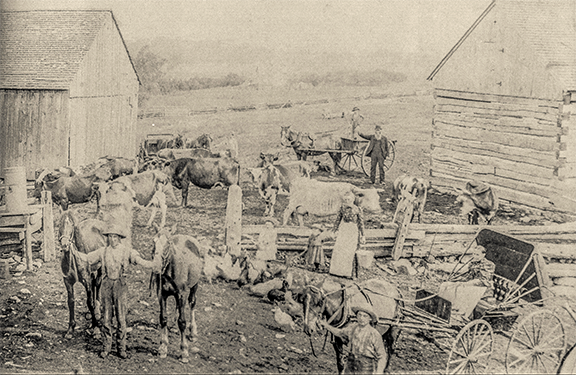
This material is from the Tweedsmuir History of Kars, Volume 3; published by the Kars Women's Institute. Courtesy of the Rideau Branch of the City of Ottawa Archives, North Gower
The building of the Rideau Canal between 1826 and 1832 helped to open up the country along the Rideau shores much sooner than it otherwise would have. It drained what was mainly a cedar swamp, making agricultural land of it, and opened up the forested countryside.
The Rideau project attracted people from the British Isles, the United States and other parts of Canada. As a result, Garlick and his lumbermen were followed by such settlers as Eastman, Ewan, Christie, Wallace, Lindsay and Thompson.
In London in 1829, John MacGregor published a small practical book entitled "Prospects for the Settler in British North America." In it he said, "Gentlemen farmers do not succeed, because of the high cost of labour. Farmers must be prepared to work. Tradesmen such as joiners, stonemasons, saddlers, shoemakers, tailors, blacksmiths, cart, mill and wheelwrights, will always find employment. To gentlemen educated for the professions of law, divinity, or physic, British America offers no flattering prospects. The man who has the most numerous offspring is considered to have the best opportunity of prospering in this country where land is abundant and the price of labour is so high."
In the 1830's fancy cattle and horses were out of the reach of most inhabitants, most of whom thought themselves well off if they could find the wherewithal to pay for a native Canadian cow, which could then be purchased for eight to ten dollars in money. These early brown-black cattle were brought to Canada from Northern France by Jacques Cartier in the late 1600's.
They had to be hardy to survive the poor care they received in the winter. By the early 1800's people realized that the Habitant cattle were good milkers if they received decent food, and they formed the basis of the early cattle in this area.
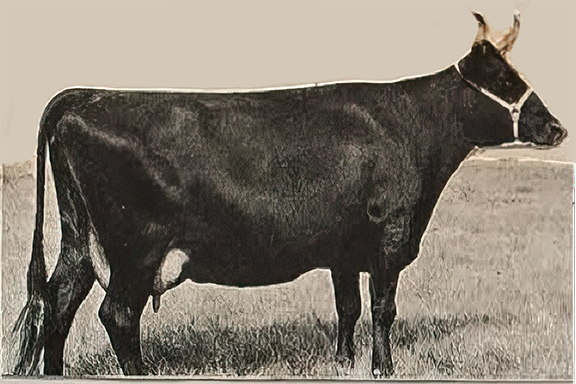
The picture above shows the Canadian cow, as it had developed by 1963.
While most immigrants in a strange land suffered from homesickness, the Scots seemed to have felt it most keenly. In 1831, a lonely Scottish settler in rural Ontario told how the omnipresent forest saddened him, in a poem beginning:
“I canna ca' this forest hame,
It is nae hame to me;
Ilk tree is suthern to my heart
And unco to my e'e."
Immigration, as opposed to true pioneer movements, such as those of the Loyalists can hardly be said to have commenced until the late 1820's. From the years 1825 to 1840 came most of the ancestors of the English-speaking population of Ontario, of non-Loyalist or non-American descent. They came to escape the effects of the Indus- trial Revolution in Great Britain, the potato famine in Ireland, and the extreme poverty of the crofters in Scotland. This movement ceased when the exhaustion of good land rendered the attractions of Canada less obvious.
In the frontier economy, sheep were of a primary importance for the production of wool for clothing and of meat and cheese for food.
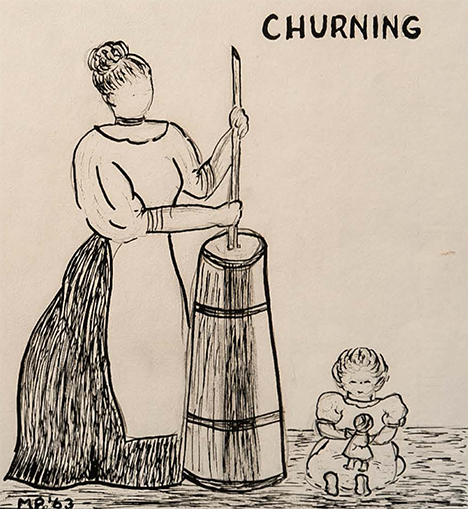
1875 - 1895
The opening of new lumber areas was followed by the development of agriculture, chiefly in the production of oats, hay and horses. When the best lands were settled, there was less local demand for livestock, and export trade in animal products was possible. By 1880 the demand for horses had increased as a result of the improvements of roads, and the rise of teaming.
In addition to the lumber districts, horses were sold for use in the American Iron and Steel industry after the Civil War. Canadian horses, fed on oats and hay were regarded as stronger boned than the corn-fed American horses. Carleton County exported horses to Pennsylvania, where they were finished to be sold in Boston and New York for carriage horses and for the streetcars.
The hog industry expanded slowly and provided only the coarse salted mess pork for local consumption, and for the demands of the lumber industry. Improved techniques in agriculture and the rise of the towns were factors contributing to the growth of the cattle industry. Dairy farmers campaigned against sheep raising in favour of hogs, possibly as they could see no possible conflict to themselves with hogs. Had the number of sheep grown, they could have competed in the cheesemaking, the tanning industry, and in meat production. Hogs, however, posed only a two-fold threat, that of meat and of hides.
The increase in the size of towns and villages created demands for dairy products. The dark red Durham cattle had developed as a basis of livestock trade, because of their dual-purpose, for meat and milk. They in turn supported the dairy industry. Even as late as 1885, there were few of the black and white Holstein cattle in this area. This breed became popular because it gave a large quantity of low fat milk, but it needed good pasture to give the best production.
The expansion of the livestock and dairy industry provided a marked change in agricultural methods. This necessitated growing very large crops of forage for use in the winter, especially timothy, clover, and of swedes, and mangels, which were stored in root cellars. This in turn encouraged the implement makers to produce seeding and haying equipment to help the farmer with his work.
Over seventy-five per cent of the population was rural in the 1880's.
1895 - 1915
In the early 1900's the change from cheap land, hand tools and farming to raise only what was needed on the farm for food and clothing, to farming as a commercial under- taking came about. Farmers often lost money by doing business and keeping accounts in their heads. In 1895, too, it came about that land could be sold if taxes were three years in arrears. However, the owner could claim it within a year for the taxes, plus ten percent. Land speculators abounded and many made money from hardworking men. In a farming manual printed in 1895 to help farmers with their business affairs, various forms for promissory notes, deeds and accounts were given, as well as instruction in basic handwriting. It warned the farmer to buy only horses that were accredited either "free from vice and quiet to ride or drive", or ones "warranted kind, sound and willing." It pointed out that this simple form would enable the purchaser to return any horse that was not workable, and so free the farmer from worry in the purchase of animals for his own use in transportation.
With the introduction of machinery, money became necessary to the farmer. It was no longer the measure of a successful farmer to be able to raise his own food and clothing and to supplement the few needs he could not produce on the farm for his family with a surplus to trade at the village store.
The farmer's wife was an important partner on the farm. She usually helped look after the poultry, the eggs, and the vegetable garden. She made butter, cleaned the milk cans and separator, baked bread and preserved and canned. She looked after her family and went to church, but rarely had much time for anything else, since her daily chores took most of her time. She did not feel over- burdened as all the other women of her acquaintance on the farms did as much or more than she. If her husband had acquired the art of farming by the school of experience, that was all that he needed to have a reasonable chance of becoming a successful farmer.
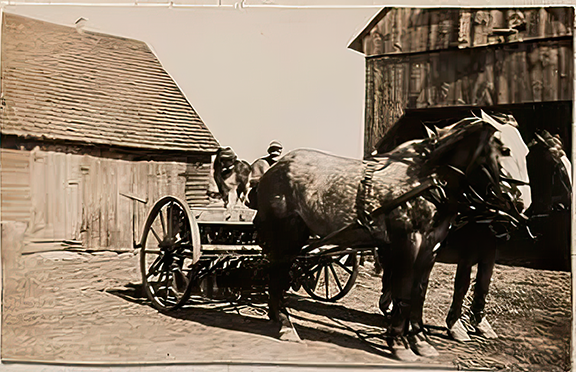
The picture above was taken in the 1930's on Lot 11, Concession I, North Gower Township, and donated to the Tweedsmuir History by Mrs. John Kirkpatrick in 1963, shows Mr. Lorne Lakeman preparing to go to the fields to seed, with his team of Barney and Rock.
Most farms supported mixed farming. They each had a few pigs, and sometimes would raise fifteen or twenty and sell the carcasses on the Market in Ottawa in the winter. Each farm still kept poultry for home consumption and several horses, from three to five was an average number per farm. Some farmers grew market vegetables in quantity to sell in winter in the Byward Market in Ottawa. Mr. Harold Rice tells of heating hardwood blocks in the oven over night and packing them around the bags of potatoes to keep them from freezing on the sleigh on the twenty-mile trip to Ottawa. He tells of leaving just after midnight for the five-hour trip to arrive just as the Market opened. Other farmers sold hay in Ottawa in the winter. They would leave around four in the morning after milking, and travel with several sleighs in convoy, while each driver kept a kerosene lantern between his knees under the buffalo robes, to keep him from freezing on the long trip. These men received much better prices for their goods in the winter, and this made the inconveniences of winter travel worthwhile.
An average farmer milked ten to fifteen cows, some by hand and some owned gasoline milking machines. Generally, the cows went dry about Christmas and freshened in March or April. The family made enough butter in the fall to carry through until spring, as well as making sure of their supplies of other staples for winter.
Each farmer usually worked independently except at harvest time when he would join with his neighbours in a threshing gang. Thus, by using machinery and better farming methods, it became possible for one family to produce enough to feed two families. This made it possible for half of the population to do other kinds of work and at the same time the farmer was able to become a buyer of manufactured goods.
1935-1946
About 1935, many farmers decided to change over from shipping milk to cheese factories, to shipping fluid milk to the dairies in Ottawa. Some began the change by shipping sweet cream. This change involved keeping the milk cool and unsoured in the warm weather, and so added another job to the farmer's schedule. An ice-cutting machine worked on the Rideau River and sold the ice at so much per block. Each farmer had to haul the two-hundred-pound blocks home himself, and he usually needed about a thousand blocks. He then had to find old sawdust to pack the ice in, for new sawdust only melted the ice. This sometimes meant that he had to go as far as Kemptville or Ottawa in search of the sawdust.
Keeping the cows milking in the winter meant that more and better-quality feed was required, and this again meant more work, and made mechanization more necessary. Soon after the outbreak of the Second World War in 1939, hired help disappeared either into the armed forces or the cities for war work. Most city people then had either grown up on the farm or had friends or relatives in farming, and these city dwellers were close to the rural people in business and social contacts. This meant that they had an understanding of each other's problems.
Farming became an important part of the economy during the war, and farmers themselves were exempt from military service. They had to become mechanized to survive without labour so it soon was no longer enough to learn farming by experience alone, the farmer had to learn technical management through reading, listening and experimenting.
1946 - 1963
After the War many people did not return to the farms. They found the money in the cities easier to earn, and the were able to afford luxuries unheard of on the farm. However, those who did return to the farms felt that living was cheaper in the country, because a farmer could live his own life, he could spend money if he had it and if he did not, he could economize. In the city it was harder to resist spending, but as the farmer saw fewer cases of expensive living, he felt free to do as he chose.
Some families returned to farm part time and to work away from the farm several days a week. Sometimes this was successful, if enough money was earned at the job off the farm, but very often the farm itself deteriorated from lack of attention and soon did not provide the share of living that it should. Many people felt that it was better in the long run to farm full time or not at all, as the short term financial advantages were outweighed by the long term loss of farm investment.
With the introduction of the baler for haying, much of the backbreaking labour was taken out of this important job.
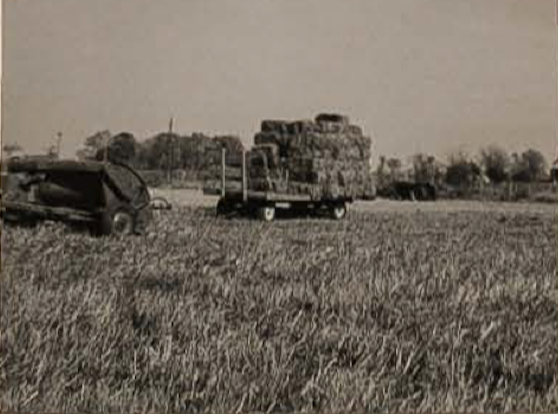
The picture above was taken in 1963 along Concession 2, North Gower Township, shows a baler with a wagon load of bales ready to go to the barn. The baler was found to be an improvement over the hay-loader of the 1930's.
When it was found to cost about $2.00 per hundred to produce milk, the farmer began to realize that he had to receive more for his milk or to try to cut his cost of production. By 1960 when the fluid milk producers had to install bulk tanks or lose their milk contracts, some felt that the expensive renovations necessary were not worth- while for them and went back to shipping milk to cheese factories. The fluid milk producers increased their milking herds, and became specialized farmers, in that they could raise no other livestock on their farms.
Those who did not install tanks made other improvements, some enlarged their barns, but still kept old buildings for other animals.
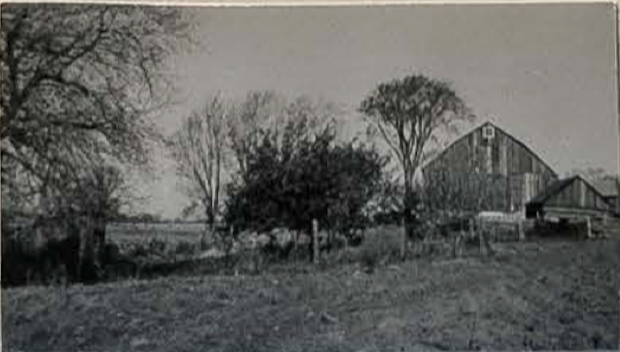
The picture above, taken in 1963 on Lot 25, Concession, 1 North Gower Township, shows a newly completed cattle barn, behind an old log shed. This shed was used as a pig house and, as the picture below shows, served the purpose well.
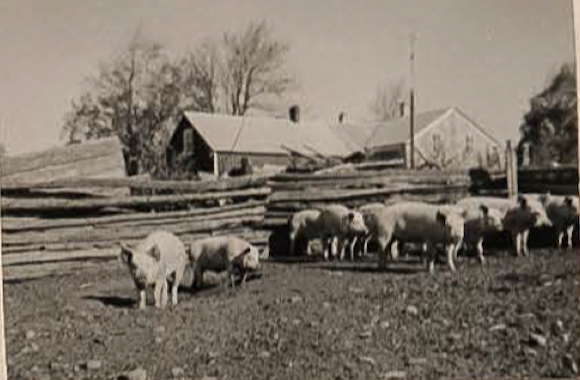
The improvement in communications helped the farmer. For example, in the winter of 1963, many were able to sell their surplus hay to the Eastern United States, where the farmers had suffered a drought, for a high of one dollar a bale, and an average of fifty cents a bale. The hay was picked up on the farms and trucked to the United States, requiring nothing on the part of the farmer, save a business head to arrange for a good selling price.
The 1960's also brought a small tractor-drawn combine. Its size made it quite inexpensive, compared to the self- propelled combine, and the farmer enjoyed the advantage of being independent and of being able to harvest his crop when it was ready.
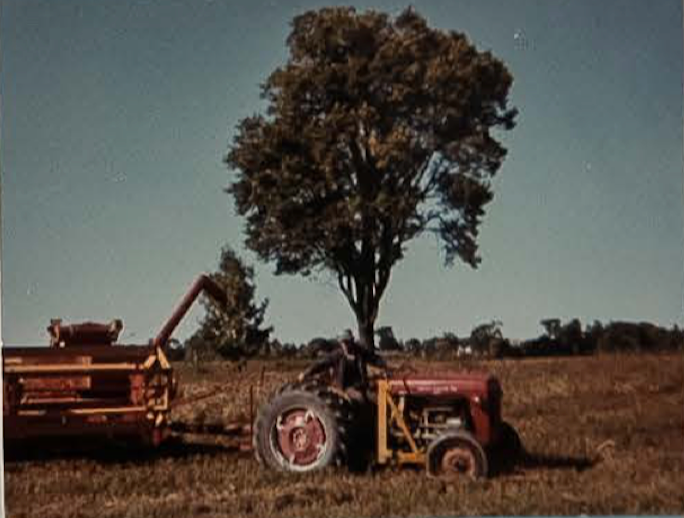
The picture above, taken in 1963, on Lot 25, Concession 1, North Gower Township, by Hugh Lindsay, shows Mr. James McNiece and his new combine. The coloured picture shows clearly that farm machinery was no longer drab nor utilitarian. This combine meant that threshing gangs were no longer essential in this area. The only chore requiring a large group of men by 1963 was corn cutting. Dairymen had found ensilage was cheap to produce as well as being a good quality feed. The corn cutting usually needed only eight or nine men, and could not be compared to the twenty to thirty men in the threshing crews of earlier days.
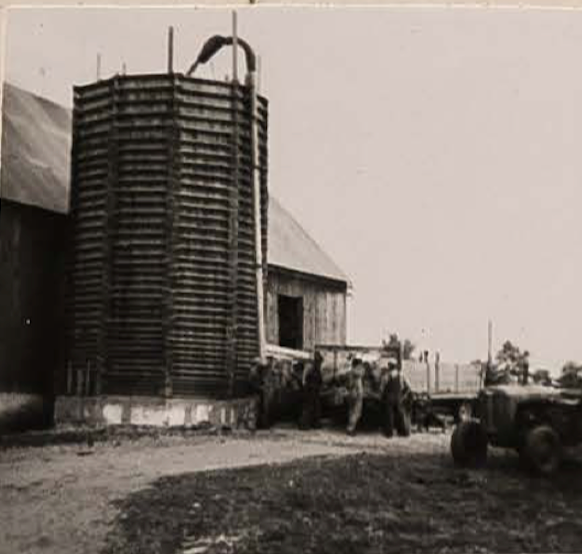
The picture above, taken on Lot 21, Concession 2, North Gower Township in 1963 shows Mr. Stanley Chambers, Fred O'Callaghan, Hugh Lindsay and Isaac Nesbitt, in the barn- yard with a load of cut corn, as the wagon is being emptied into the silo. With their larger herds, farmers found silos were needed to provide storage for feed.
As the city of Ottawa grew, many Government employers and others who worked in Ottawa moved onto farms in the area. Some lived in the farmhouses and rented the land to neighbouring farmers who needed land for their increased milking herds. Others held jobs during the day and farmed at night and on weekends. Those who chose to work and farm usually experimented for several years until they found the right way of life for them, one that did not lose money nor require more time than they could provide. Some decided to raise beef cattle or feeder calves, some raised hogs, some sheep and some hens. Others grew trees or small fruits or market vegetables. However, they left the milk-producing business completely to the full-time farmer.
The horizons of the community were widened by having so many outsiders in the area. Their ideas were welcomed on community projects and their varied talents put to use. Generally the diversification of interests made our community a better place to live. There were, however, really only four requirements to be fulfilled to be a successful farmer: To be able to make a full and comfortable living from the land; to rear a family carefully and well; to be of good service to the community; and to leave the farm more productive than it was when he began to farm.
